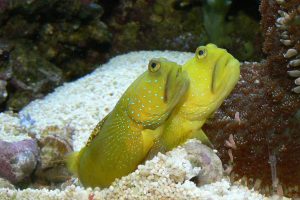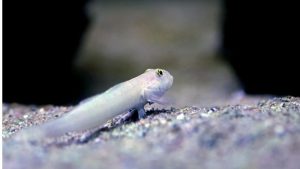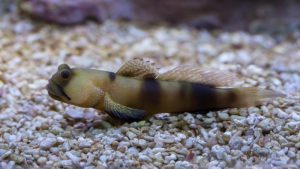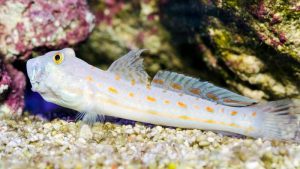This post may contain affiliate links. As an amazon associate I earn from qualifying purchase. Learn more
If you are searching for a fish that can keep your sand bed clean then sand sifting goby might be the right choice for you.
What is sand sifting goby?
Sand Sifting Gobies are fish that pick up sand in their mouths and then expel it through their gill covers. Small grain sand is recommended, so the fish don’t damage their gills.

Contents
What is the best sand sifting fish?
When we are talking about sand sifting fish the first thing that comes to our mind is Goby fish. Well, we are not far from the truth. Those are the most popular type among saltwater aquarium hobbyists.
Sand Sifting Gobies are hardy fish and easy to care for if you provide them with the right conditions.
If you are interested in keeping them then there are some things to consider.
Firstly, sand sifting gobies reach sizes up to 15 inches so a good practice is to keep them in 50 gallons plus tanks.
Secondly, avoid keeping Gobies with big predatory fish.
And thirdly, only buy Gobies if you have a well-established tank.
If you have the right conditions then check this list of sand sifting gobies I’ve made for you.
See Also: 7 Reasons Why Clownfish Are Great Fish for Beginners
Sleeper Blue Dot Goby

The Sleeper Blue Dot Goby commonly referred to as the Ladder Goby or Sixspot Sleeper Goby is a sand sifting fish easily recognized by its white body with bright blue spots under the eyes and mouth.
These types of gobies are native to the Indo-Pacific Ocean in the Red Sea, the Persian Gulf, and East Africa to Samoa. They are usually found in lagoons in waters from 9 to 82 feet.
The Sleeper Blue Dot Goby can reach sizes up to 6 inches. Keep them in at least 30 gallons tanks with a temperature of 72 to 78 F, dKH 8-12, and PH 8.1-8.4. Keep in mind that you should house them in tanks with sand. After all, they are sand sifting gobies.
They have a peaceful temperament and are not aggressive towards other fish. However, they are territorial against their kind. In general, you should avoid keeping them with more aggressive fish too. The best practice is to keep them in pairs. In the wild, they mate for life.
These Gobies are so popular because of their ability to sift the sand and make it clean. Many aquarists claim that if you want to get rid of brown algae on the bottom of your tank, then this is the right goby for you. It’s so fun to watch these little guys dig homes under almost every rock in the tank.
Sometimes is difficult to feed these types of gobies because they don’t accept commercially available foods. In that case, target feeding is your best solution.
See Also: Clownfish Tank Setup (The Definitive Guide)
Engineer Goby
The Engineer Goby (Pholidichthys Leucotaenia) commonly referred to as Pacific Neon Goby, Worm Goby, and Convict Goby is a saltwater fish with a black body and white horizontal stripe from the eye to the tail. When it gets older the stripes turn vertical.
These species are native to the Indo-Pacific Ocean from Australia to the Philippines, north to the Ryukyu Islands, and south to the southern Great Barrier Reef.
The Engineer Goby can grow up to 1 foot. It’s a pretty big goby so the minimum tank size should be 70 gallons. Keep them in tanks with a temperature of 72 to 78 F, dKH 8-12, ph 8.1-8.4, and sg 1.020-1.025. They are successfully bred in home aquariums and are fairly inexpensive fish.
They are very hardy and peaceful fish that will be a nice addition to your reef tank. Their unique behavior of burrowing through the sand is always a pleasant sight to watch.
These types of gobies are carnivorous and the majority of their diet consists of meaty foods. Feed them twice a day with a mixture of Brine Shrimp, Mysis Shrimp, and live black worms.
Rainford Goby
The Rainford Goby (Koumansetta Rainfordi) also known as Court Jester Goby or Old Glory is a saltwater fish with a green body and horizontal orange stripes running the entire length of the body.
These types of gobies are native to the Indo-Pacific Ocean and Western Pacific Ocean. They are usually found in waters at depths from 2 to 30 meters.
These fish can reach a maximum size of up to 3 inches. Keep them in at least 10 gallons tanks with a temperature of 72 to 78 F, dKH 8-12, ph 8.1-8.4, and sg 1.020-1.025.
With the increasing popularity of this beautiful hobby, Rainford Gobies are now available in almost every aquarium shop. They are successfully bred in captivity and you shouldn’t have trouble finding them.
Court Jester Gobies are easy to keep and fairly peaceful fish. If you want to see their natural behavior keep them in groups of five or more. Unlike other Gobies, this type is rarely aggressive towards each other. Make sure you provide plenty of hiding places among rocks to see them thrive in your tank.
They are reef-compatible and well-known algae grazers. They eat small crustaceans, such as live worms, frozen brine shrimp, and algae.
Diamond Watchman Goby
The Diamond Watchman Goby (Valenciennea Puellaris) also known as Orange Spotted Diamond or Orangespotted Sleeper Goby is one of the most popular types of gobies. These little guys are easily recognized by their white bodies with orange spots.
These species of gobies are found in the Indo-Pacific Ocean and can reach sizes up to 6 inches. The minimum tank size for these fish is 30 gallons.
When someone is asking what’s the best sand sifting fish almost every time the answer from hobbyists is the diamond Watchman Goby.
And it’s easy to see why. These guys love to burrow in the sand, which is beneficial because it’s keeping the substrate well oxygenated.
Usually, they are not aggressive towards each other, however, they can be territorial. A good practice is to keep them in pairs.
Like any other saltwater fish, the Diamond Watchman Goby will benefit from a diverse diet. Feed them live black worms, Mysis shrimp, frozen brine shrimp, and other prepared foods.
Tiger Watchman Goby

The Tiger Watchman Goby (Valenciennea wardii) commonly referred to as Ward’s Sleeper or Tiger Sleeper Goby is popular sand sifting goby among saltwater aquarium hobbyists. It’s easily recognized by its white body with brown bands and an eyespot on the first dorsal fin.
These species are found in Indonesia and Sri Lanka and can grow up to 5 inches. Keep them in at least 30 gallons tanks. It is not aggressive towards other fish, however as any other Watchman Goby can be territorial.
In general, people avoid these types of gobies because is very difficult to keep them long-term. They need a large, established sandbed to feed off all day. However, they will happily accept commercial foods once acclimated.
What do sand sifting gobies eat?
Their primary diet is small invertebrates that live in the sand. They pick up sand in their mouth and filter what’s edible from what’s not through the gills.
Unless you have an established sand bed is very difficult to keep sand sifting gobies long-term. It’s a hard task to get them to use to prepared foods. If you’re willing to purchase sand sifting goby, always look for the ones that already eat prepared food in your local fish shop.
Final Thoughts
Sand Sifting Gobies can be a nice addition to your reef tank. However, you must be careful.
Keeping them in the wrong conditions can quickly go wrong for both aquarists and corals.
However, I’d like to hear from you:
What’s your favorite sand sifting goby from this list?
Or maybe you have another suggestion?
Either way, let me know in the comment section.
Featured Image: CC BY-SA 3.0

I just brought home a yellow watch man goby two days ago I don’t see it’s sift the sand and why it don’t it hides in a rock and peak
Give it time to your goby to accustom to the new environment.
The Diamond Watchman goby is my fave. The only drawback is that they jump very well . I purchased one years ago with my first aquarium but wasnt told by the LFS that they are great flyers. Next day I went crazy looking for my prized little fish. Days went by and I figured he must of buried himself in the sand. Never thought of looking for it on the floor! I was so upset because the LFS should of told me to get a tight fitting cover on my aquarium.
I brought one and he did sand sift, however, he always deposited his sand on top of my corals. so I moved him to a fish only with live rock tank and he did the same though the sand bed is clean….